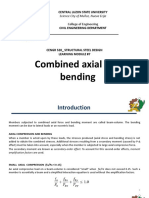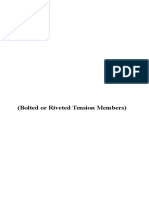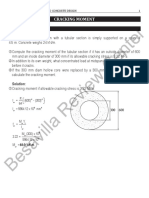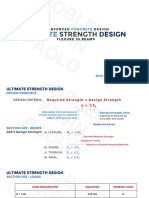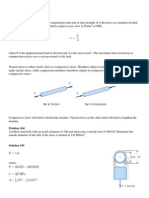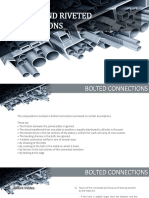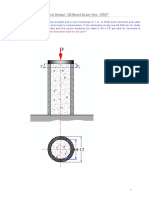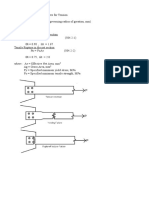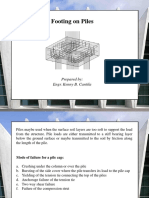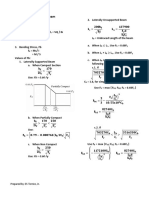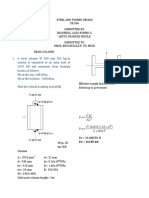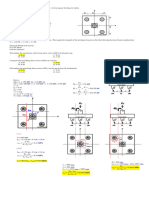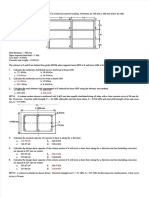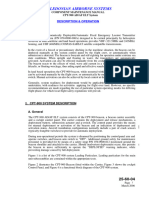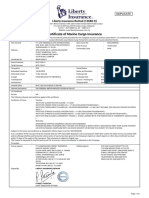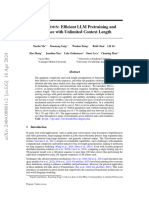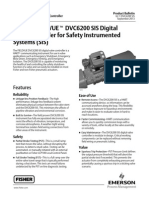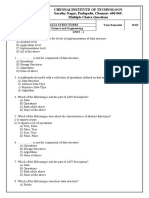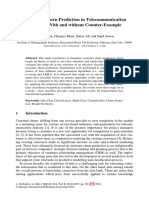Steel - Bolt
Steel - Bolt
Uploaded by
アニナ ロンガロンCopyright:
Available Formats
Steel - Bolt
Steel - Bolt
Uploaded by
アニナ ロンガロンOriginal Description:
Copyright
Available Formats
Share this document
Did you find this document useful?
Is this content inappropriate?
Copyright:
Available Formats
Steel - Bolt
Steel - Bolt
Uploaded by
アニナ ロンガロンCopyright:
Available Formats
1.
A plate with width of 300mm and thickness of 20mm is to be connected to two plates of the same width with half the thickness by 25mm diameter rivets, as shown. The rivet holes have a diameter 2mm larger than the rivet diameter. The plate is A36 steel with yield strength Fy=248 MPa, allowable tensile stress of 0.60Fy and allowable bearing stress of 1.35Fy. The rivets are A502, Grade2, hot-driven rivets with allowable shear stress of 150 MPa. a. Determine the maximum load, in KN that can be applied to the connection without exceeding the allowable tensile stress in the plates. b. Determine the maximum load, in KN that can be applied to the connection without exceeding the allowable shear stress in the rivets. c. Determine the maximum load, in KN that can be applied to the connection without exceeding the allowable bearing stress between the plate and the rivets.
Solution: Allowable tensile stress in plates: Ft = 0.6Fy = 0.6(248) Ft = 148.8 MPa P = FtAn An = [300-2(25+2)](20) An = 4920mm2 P = 148.8(4920) = 732,096 N P = 732 KN Allowable shear stress in plates (double shear): P = FvAv Fv = 150 MPa Av = 2Ab x 4 = 2[(/4)(25)2] x 4 = 3947mm2 P = 150(3947) = 589,050 N P = 589 KN Allowable bearing stress in rivets: Fb = 1.35Fy = 1.35(248) = 334.8MPa Ab = 25(20) x 4 = 2000mm2 P = 334.8(2000) = 669,600 N P = 669.6 KN
2. The two plates shown are joined together by four 25-mm rivets. Allowable shearing stress for the rivets is 70 MPa, allowable tensile stress on net area of the plates is 100 MPa, and the allowable bearing stress on contact area between the rivet and the plate is 140MPa. a. Determine the maximum value of P such that the allowable shearing stress in the rivets will not be exceeded. b. Determine the maximum value of P such that the allowable tensile stress in the plates will not be exceeded. Solution: Shearing on rivets: P = FvAs P = 70[(/4)(25)2 x 4] = 137,445 N P =137.445KN Tearing on net area of plates For the 14mm thick plate: (0.85Ag = 1547mm2) Tearing along rivet a An = (130-27)(14) = 1442mm2 P = 100(1442) = 144200 N = 144.2KN Tearing along rivet b-c An = (130-27x2)(14) = 1064mm2 P-P/4 = FTAn 3p/4 = 100(1064) P = 141867 N = 141.87KN For the 10mm thick plate: (0.85Ag = 1275mm2) Tearing along rivet d An = (150-27)(10) = 1230mm2 P = 100(1230) = 123000 N = 123KN Tearing along rivet b-c An = (130-27x2)(10) = 960mm2 P-P/4 = FTAn 3p/4 = 100(960) P = 128000 N = 128 KN Therefore, the safe P = 123KN Based on bearing: (The thinner plate is more critical in bearing) P = FbAb = 140[25(10)x4] = 140000 N = 140KN
3. A steel plate is 360mm wide and 20mm thick with four bolt holes cut into a plate as shown. Determine the critical net area of the section.
Solution: An = t Wn Solving for critical net width: Path ABEF: Wn = 360-25(2) + Path ABCEF: Wn = 360-25(3) + Path ABCDEF: Wn = 360-25(4) + + = 281.25 mm + = 290.94 mm = 310.83 mm
Use Wn = 281.25mm Then; An = 20x281.25 = 5625mm2
4. A riveted lap joint is shown. The rivets have 16mm diameters, and the permissible stresses are 124MPa for shear in rivets, 296MPa for bearing, and 165MPa for tension (on net area) in plates. The plates are 10mm thick. Assume hole diameter be 1.5mm larger than the rived diameter. a. Determine the safe value of P such that the allowable bearing stress in the rivets will not be exceeded. b. Determine the maximum value of P such that the allowable tensile stress in the rivets will not be exceeded. c. Determine the safe value of P. Solution: Shearing on rivets: P = 124[(/4)(16)2 x5] = 124,658 N P =124.658 KN Tearing along a-a An = [200-(16+1.5)](10) = 1825 mm2 0.85Ag = 0.85(200)(10) = 1700 mm2 P = 165(1700) = 280,500 N = 280.5 KN
Tearing along b-b An = [200-(16+1.5)(30)](10) = 1475 mm2 P-P/5 = 165(1475) P = 304.218 KN Bearing: P = 296[16(10)]X 5 = 236.8 KN Safe value of P = 124.6 KN
5. A plate with width of 400mm and thickness of 12mm is to be connected to a plate of the same width and thickness by 34mm diameter bolts, as shown in the figure. The holes are 2mm larger than the bolt diameter. The plate is A36 steel with yield strength Fy= 248 MPa. Allowable tensile stress is 0.60Fy. It is required to determine the value of b so that the net width along bolts 1-2-3-4 is equal to the net width along bolts 1-2-4. a. Determine the value of b in mm. b. Determine the value of the net area for tension in plates in mm2. c. Determine the maximum value of P such that the allowable tensile stress will not be exceeded.
Solution Net width = Gross width holes + Net width (1-2-4) = net width (1-2-3-4) 400- 3(34+2) + + + + + = 400 4(34+2)
b = 19.71 Considering path 1-2-3-4 or path 1-2-4 Wn = 400 3(34+2) + Wn = 322.22 mm +
Considering path 1-2-3 Wn = 400 3(34+2) + Wn = 301.97 mm Critical net area = 301.97(12) = 3624 mm2 P = 3624 x [0.6(248)] = 539.2 KN +
You might also like
- Bolted Connections Sample Problem 1:: SolutionDocument99 pagesBolted Connections Sample Problem 1:: SolutionAndrea Kimberly Arpon40% (5)
- Steel5 ( 39pages)Document45 pagesSteel5 ( 39pages)Kristin Brienne Leander-Renomeron100% (3)
- Module 7-Combined Axial and BendingDocument55 pagesModule 7-Combined Axial and BendingPeter Harold Maducdoc67% (3)
- MODULE1 - 134 Prents 1 1 3 PDFDocument113 pagesMODULE1 - 134 Prents 1 1 3 PDFAlesther Mariano100% (1)
- MidtermsDocument32 pagesMidtermsmayka mawrin0% (1)
- Bolted or Riveted Tension MembersDocument39 pagesBolted or Riveted Tension MembersKristin Brienne Leander-Renomeron88% (8)
- For Printing Bolted ConnectionDocument10 pagesFor Printing Bolted ConnectionLouvern Jake Dosono Reyes67% (3)
- Bolted ConnectionsDocument16 pagesBolted ConnectionsCharizza Montarin CENo ratings yet
- Jasper PDFDocument72 pagesJasper PDFLimuel Milo Lebios100% (2)
- Steel1 (26pages)Document26 pagesSteel1 (26pages)Kristin Brienne Leander-Renomeron50% (2)
- Compression Members PDFDocument27 pagesCompression Members PDFCharlyn Costales100% (4)
- Practice Problems PDFDocument8 pagesPractice Problems PDFJea Clarie Mendioro EspinasNo ratings yet
- SNNDNDNDDocument5 pagesSNNDNDNDRowena Remorosa Galay100% (1)
- Module 37 - Steel Beams 2001 and Steel PurlinsDocument3 pagesModule 37 - Steel Beams 2001 and Steel PurlinsClark Sibi100% (1)
- EXAM TIP STRENGTH OF MATERIALS (Repaired)Document1 pageEXAM TIP STRENGTH OF MATERIALS (Repaired)Bee-Anne Bautista FranciscoNo ratings yet
- Week 1 Reinforced Concrete PDFDocument18 pagesWeek 1 Reinforced Concrete PDFmuhammad rid100% (1)
- Steel Design Problem SetDocument19 pagesSteel Design Problem SetMiah N. Pascual100% (1)
- 5 CE133P Ultimate Strength Design Flexure Revised (Robles) 2Document31 pages5 CE133P Ultimate Strength Design Flexure Revised (Robles) 2KC Paguinto0% (1)
- Simple Stresses From MathalinoDocument58 pagesSimple Stresses From MathalinoGien Lim100% (5)
- Strength of MaterialsDocument61 pagesStrength of MaterialsEkajara JoshNo ratings yet
- Damien Elite C-7Document3 pagesDamien Elite C-7m43238No ratings yet
- Bolted Connection ModuleDocument5 pagesBolted Connection ModuleMakolNo ratings yet
- PSD 323 Module 3Document17 pagesPSD 323 Module 3Edrick BelerNo ratings yet
- Welded ProblemsDocument6 pagesWelded ProblemsIan BondocNo ratings yet
- Problem 1 Ce Board Nov 2011, Nov 2013: Answer: 150mpa, 119.4mpa, 51.69mpaDocument4 pagesProblem 1 Ce Board Nov 2011, Nov 2013: Answer: 150mpa, 119.4mpa, 51.69mpaLester John Precillas100% (1)
- STEELDocument52 pagesSTEELIan Bondoc100% (1)
- Steel4 ( 36pages)Document36 pagesSteel4 ( 36pages)Kristin Brienne Leander-RenomeronNo ratings yet
- Design of Beams 1Document30 pagesDesign of Beams 1Jill Relador100% (1)
- Module 6 Structural Steel Design 2Document21 pagesModule 6 Structural Steel Design 2Rich Lenard L. MagbooNo ratings yet
- Steel Design Problem SetxzDocument35 pagesSteel Design Problem SetxzMiah N. PascualNo ratings yet
- Reinforced ConcreteDocument15 pagesReinforced ConcreteDenice Castro100% (1)
- Bolted ConnectionnDocument22 pagesBolted ConnectionnErica Geronimo100% (1)
- Summary. Structural Design "CE Board Exam Nov. 1992 PDFDocument22 pagesSummary. Structural Design "CE Board Exam Nov. 1992 PDFAlvinNo ratings yet
- C2. Design of Tension Members 5f5b10a29c9d2 PDFDocument15 pagesC2. Design of Tension Members 5f5b10a29c9d2 PDFSantos, John Paul R.No ratings yet
- Steel in EngineeringDocument3 pagesSteel in EngineeringJay Anne Mae FebreNo ratings yet
- Topic 6 - Pile FootingDocument27 pagesTopic 6 - Pile FootingDhanmer Lopez0% (2)
- Beam Design - 2020Document4 pagesBeam Design - 2020Najib A. CasanNo ratings yet
- Lesson 5.1 - Shear Strength in BeamsDocument12 pagesLesson 5.1 - Shear Strength in BeamsManibog April MaeNo ratings yet
- STEEL ProblemsDocument21 pagesSTEEL ProblemsFrances Nicole QuitoNo ratings yet
- 5 Design of Tension Members PDFDocument3 pages5 Design of Tension Members PDFCristan RetuermaNo ratings yet
- PurlinDocument24 pagesPurlinLester Neil Lomod0% (1)
- Analysis of Reinforced Concrete BeamsDocument87 pagesAnalysis of Reinforced Concrete BeamsJomarie Alcano67% (3)
- One Way Slab and Standard HooksDocument21 pagesOne Way Slab and Standard Hooksmuhammad rid100% (1)
- Tension Members PDFDocument21 pagesTension Members PDFMaribeth Salvador50% (2)
- Shear StrengthDocument17 pagesShear StrengthVon San Jose100% (1)
- Answer: 250Mm, 0.74mpa, 2.75M: Reinforced Concrete - Lecture03 - August2019Document5 pagesAnswer: 250Mm, 0.74mpa, 2.75M: Reinforced Concrete - Lecture03 - August2019hazelNo ratings yet
- A. For T-SectionsDocument17 pagesA. For T-SectionsJio SandagNo ratings yet
- Reinforced and Prestressed Concrete DesignDocument37 pagesReinforced and Prestressed Concrete DesignJoshua John Julio100% (1)
- Problems - Timber & Construction: Situation: Problem 1 To 3 (May 2000)Document23 pagesProblems - Timber & Construction: Situation: Problem 1 To 3 (May 2000)Caro Kan Lopez100% (1)
- Steel Problem Set FinalDocument27 pagesSteel Problem Set FinalJayChristian Quimson100% (1)
- Preboard2 Psad Situation 3 Pile FootingDocument1 pagePreboard2 Psad Situation 3 Pile FootingAngelice Alliah De la CruzNo ratings yet
- PDF Concrete Designdocx DDDocument19 pagesPDF Concrete Designdocx DDAlexes DomingoNo ratings yet
- Problem 6: Answer: 138.24kN, 157.93kN, 304kNDocument1 pageProblem 6: Answer: 138.24kN, 157.93kN, 304kNMarvin Carl GranadaNo ratings yet
- Analysis and Design of Doubly Reinforced BeamDocument18 pagesAnalysis and Design of Doubly Reinforced BeamKherstine Muyano TantayNo ratings yet
- Design of Rectangular FootingDocument9 pagesDesign of Rectangular Footingsairin park100% (2)
- Exam Steel DesignDocument2 pagesExam Steel DesignAndrew PortugalNo ratings yet
- 11 - Design of One-Way Slabs PDFDocument23 pages11 - Design of One-Way Slabs PDFAndrea Sochayseng SolijonNo ratings yet
- Compression Members CE137-1 - ESCRUZDocument25 pagesCompression Members CE137-1 - ESCRUZNash GNo ratings yet
- HandoutsDocument3 pagesHandoutssheena Marjorie Cabidog100% (1)
- SOM Module-3Document8 pagesSOM Module-3Mark Charael MarfilNo ratings yet
- Mid Pre BoardDocument6 pagesMid Pre BoardJonathanNo ratings yet
- CH 8 Ethics TechnologyDocument11 pagesCH 8 Ethics Technologychfgvjkl;No ratings yet
- Disk PartDocument3 pagesDisk PartFrancis Manon-ogNo ratings yet
- .TR 2023 Bahar Yökdi̇l Sosyal-Sinav KampiDocument29 pages.TR 2023 Bahar Yökdi̇l Sosyal-Sinav KampiDoğukan UlusoyNo ratings yet
- CPT-900 ADELT Manual Part2Document32 pagesCPT-900 ADELT Manual Part2Bill MonkNo ratings yet
- Edkris Semera Final Thesis 2023Document101 pagesEdkris Semera Final Thesis 2023Duke GlobalNo ratings yet
- Asrnsi 6203Document2 pagesAsrnsi 6203he ryNo ratings yet
- JIDE Components Developer GuideDocument30 pagesJIDE Components Developer Guidesales8085No ratings yet
- Public Water Service, Sanitation, Public-Private Partnership, Performance Evaluation, ConstantineDocument29 pagesPublic Water Service, Sanitation, Public-Private Partnership, Performance Evaluation, ConstantineTaharBrakniaNo ratings yet
- Prepositions of Place Lesson PlanDocument5 pagesPrepositions of Place Lesson PlanLaura VelasquezNo ratings yet
- Worksheet Figurative Devices 9Document11 pagesWorksheet Figurative Devices 9cherifa abdallahNo ratings yet
- Resources For Your Pura Vida Lifestyle by FBRDocument61 pagesResources For Your Pura Vida Lifestyle by FBRSherelyn SanchezNo ratings yet
- Connoisseur of Chaos: SchnittkeDocument6 pagesConnoisseur of Chaos: SchnittkeRobert MorrisNo ratings yet
- Chapter 14Document49 pagesChapter 14Ram SskNo ratings yet
- Shaping Violin or Viola CornersDocument19 pagesShaping Violin or Viola CornersJairo Duarte100% (3)
- Plenary-1 - ESG in IndonesiaDocument20 pagesPlenary-1 - ESG in IndonesiasarahNo ratings yet
- Installation Manual (English)Document111 pagesInstallation Manual (English)centralsawing.technicianNo ratings yet
- Pipes SS316Document7 pagesPipes SS316Ruano Andreola StumpfNo ratings yet
- Megalodon: Efficient LLM Pretraining and Inference With Unlimited Context LengthDocument18 pagesMegalodon: Efficient LLM Pretraining and Inference With Unlimited Context LengthJohnNo ratings yet
- 350 Series Broce Broom Parts Catalog 404001-404561 MANUAL BA-04Document126 pages350 Series Broce Broom Parts Catalog 404001-404561 MANUAL BA-04Eduardo SainzNo ratings yet
- Fisher FIELDVUE DVC6200 SIS Digital Valve Controller For Safety Instrumented Systems (SIS)Document8 pagesFisher FIELDVUE DVC6200 SIS Digital Valve Controller For Safety Instrumented Systems (SIS)Radu Costin GeorgeNo ratings yet
- Control: Specification Connection DiagramDocument1 pageControl: Specification Connection DiagramSudipto MajumderNo ratings yet
- CES Business PresentationDocument50 pagesCES Business PresentationGary David CrowhurstNo ratings yet
- 1 s2.0 S0263822322002380 MainDocument16 pages1 s2.0 S0263822322002380 Main231147132No ratings yet
- Chennai Institute of Technology Sarathy Nagar, Pudupedu, Chennai - 600 069. Multiple Choice QuestionsDocument14 pagesChennai Institute of Technology Sarathy Nagar, Pudupedu, Chennai - 600 069. Multiple Choice Questionssureshvk.20087147No ratings yet
- Research Case Study BUS223 OTBDocument4 pagesResearch Case Study BUS223 OTBblazekangaNo ratings yet
- Kellogg MSMS Student FactSheetDocument2 pagesKellogg MSMS Student FactSheetarunzexyNo ratings yet
- Glencolmcille Agricultural Show Entry Booklet 2013Document16 pagesGlencolmcille Agricultural Show Entry Booklet 2013Glencolmcille ShowNo ratings yet
- HR S Guide To OnboardingDocument27 pagesHR S Guide To OnboardingAbrilNo ratings yet
- Customer Churn Prediction in TelecommunicationDocument13 pagesCustomer Churn Prediction in TelecommunicationnimaNo ratings yet


